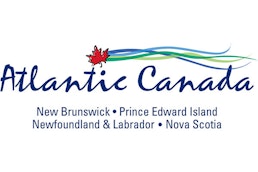A visit to the Atlantic provinces of Canada is to uncover a hidden treasure.
In a country that has so many awe-inspiring features, from the picturesque coast to the vibrant cities and quaint small towns, it’s hard to make a decision on where to go or what to see.
So let us make that decision a little easier with our expert's Atlantic Canada travel guide.
Comprising four diverse provinces, Atlantic Canada is known for its beautiful National Parks, unique wildlife, fascinating history and, of course, an abundancy of fresh seafood to dine on.
You'll be able to spot humpback whales, puffins and moose, plus marvel at glimmering icebergs, perhaps tasting the fresh lobster as you go.
The perfect place for an adventurous holiday, read on to find out more about what to expect on your holiday.
Which provinces make up Atlantic Canada?
Nova Scotia
This charming coastal peninsula of Nova Scotia is one of the four original provinces of Canada. With a fairly small land mass, this stunning area is packed with a diverse history. You’ll find that there are plenty of First Nations and western European influences on architecture, language and culture, stemming from its history as a maritime centre of commerce and home to the Mi'kmaq people.
New Brunswick
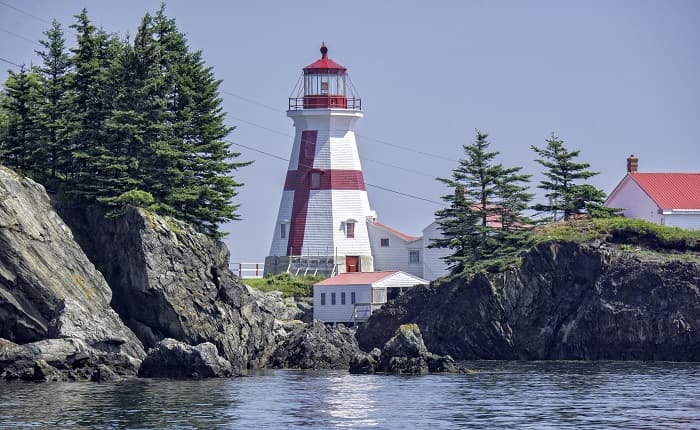
New Brunswick is an unspoiled wilderness and the ideal place to get back to nature, with world-renowned salmon rivers, an array of charming islands and a spectacular coastline with a rugged beauty that only the greatest tides on earth could possibly sculpt. Adventure calls to you at each turn, from canoeing through winding river bends to watching the beautiful colour of the trees turning from the deepest emerald to burnt orange during the autumn months.
Newfoundland and Labrador
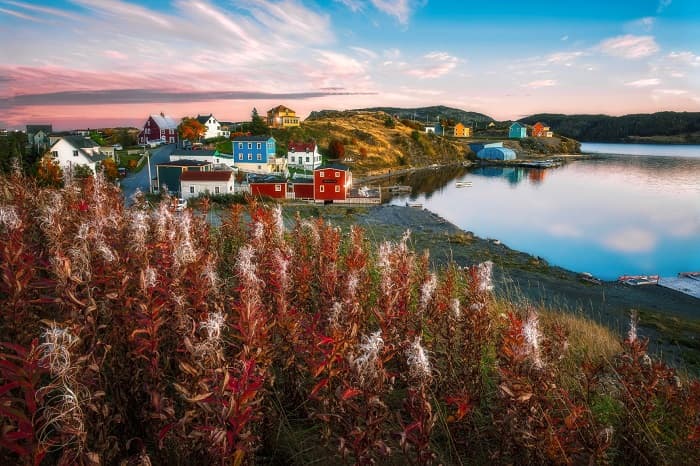
Time in Newfoundland and Labrador is best spent enjoying the great outdoors, from the stark rugged cliffs battered by the Atlantic Ocean to the beautiful interior of the province, an extension of the Appalachian Mountains that range down into the United States. In Newfoundland and Labrador you’ll find opportunities for outdoor activities, tours and experiences, including meeting the locals with their distinctive Newfoundland dialect!
Prince Edward Island
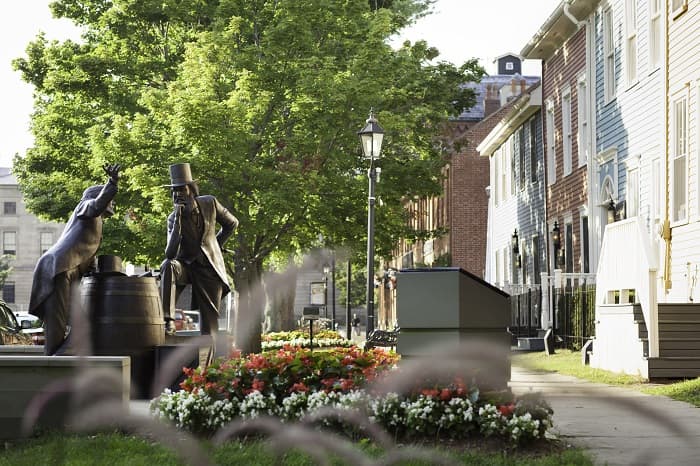
Prince Edward Island is the smallest and only island province in Canada, but even so, there's still so much to see and do here. Take a wander and enjoy the soft sandy beaches, walk through the capital of the island, Charlottetown, and taste the freshest fish around. This is the place to kick back and just enjoy the slow pace of life.
Each of the provinces has distinct features, but together they make up one outstanding region - combining them together is the best way to experience Atlantic Canada.
Let's dig a little deeper on when to visit, how to get around and the top things to do.

The Best Time to Visit Atlantic Canada
The best time to visit Atlantic Canada depends on what you'd most like to do.
You can spend summer days on the beaches of Prince Edward Island watching whales in Nova Scotia or spotting icebergs in Newfoundland and Labrador, and explore one of the Signature Trails in New Brunswick. Temperatures are quite warm in summer, with highs of between 20 and 30°C. This does, however, bring more crowds, so bear in mind that it's usually the busiest time of year.
Autumn road trips will be coloured by the changing leaves, making for breathtaking displays from mid to late September. In autumn, it's still warm in the daytime, though evenings can be cool. With fewer crowds, this is a lovely time to enjoy the beauty of the region - plus, you still have a chance of spotting some whales into September, too.
For a springtime visit, May is a wonderful month in Atlantic Canada. You'll enjoy the greenest landscapes, with long days to spend exploring everything on offer, from kayaking and canoeing to hiking and horse riding.

How to explore Atlantic Canada
Flights from the UK take around six and a half hours to Halifax in Nova Scotia. Nova Scotia is a good place to start a holiday in the Maritimes. From here, you’ll want to strike further out into the other provinces to see more.
One of the best ways to explore Atlantic Canada is by hiring a car - this way you can traverse long distances with the flexibility to make stops as you go.
We have some tailor-made self-drive tours created by our Travel Experts to help you enjoy the best of the region. Our Maritime Atlantic Canada itinerary guides you through Nova Scotia and Prince Edward Island, including the top sights and unmissable experiences.
Things to Do and See in Atlantic Canada
1. Wildlife and Whale Spotting
If you’re anything like us and love a holiday with plenty of wildlife, you’ll love Canada's Marine Provinces. You’ll find fantastic whale watching opportunities, where you can witness the majesty of these marine creatures first hand. You'll be able see them by sea on Zodiacs, catamarans, yachts and tall ships or sometimes even from land.
For the best chance to spot whales, be sure to visit these spots on your holiday...
- Along the coast of Newfoundland and Labrador from June to early September.
- In the Bay of Fundy between New Brunswick and Nova Scotia from June to September.
- Off Cape Breton Island in Nova Scotia between May and October.
While whales might seem like the stars of the show, you can also spot puffins and other seabirds, moose, black bears, polar bears in Newfoundland and Labrador, deer, caribou and more, all in their natural habitat.
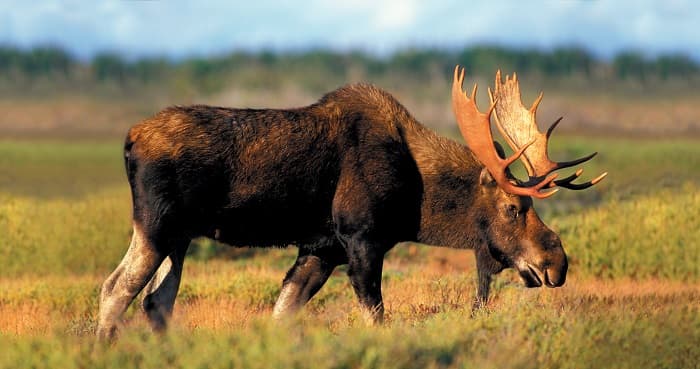
If you really want to immerse yourself in the wildlife of Atlantic Canada, take a look at this fantastic Newfoundland Wildlife itinerary tailored by our Travel Specialists - this short break gives you the chance to see the whales and puffins in the Witless Bay Ecological Reserve while staying in the charming harbour town of St John's, the province's capital.
2. Atlantic Canada's Icebergs
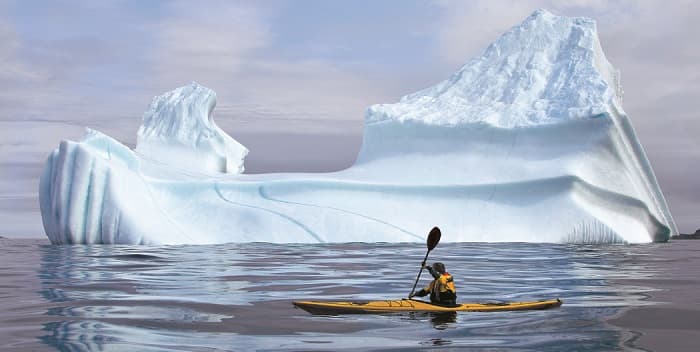
Icebergs are fascinating to see and one of the best places to do this is 'Iceberg Alley' in Newfoundland and the northern coast of Labrador.
Across the east and northern coastline during the months of April to July, you'll find icebergs that have broken off from the glaciers in Greenland and Canada. They slowly travel through the water, so you won't be able to spot them in the same place each week as they drift.
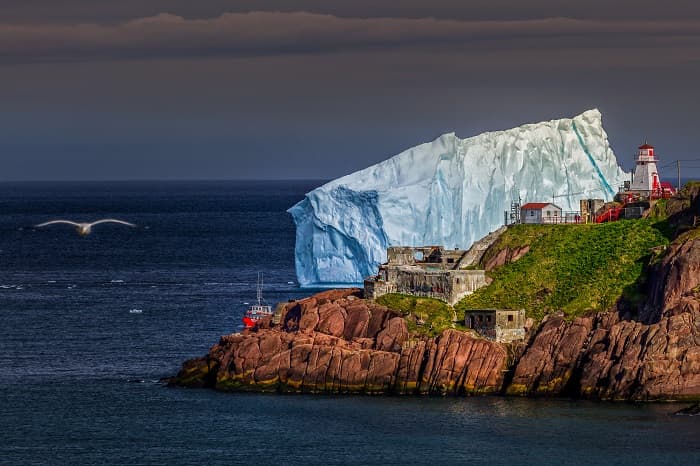
There are two great ways to view the icebergs; first from land, as you travel along the coastline, and secondly out on a boat. The magic of viewing icebergs in Atlantic Canada is that they coincide with migrating birds and whales too, creating a natural spectacle unlike any other.
If you'd love to admire the magnitude of Canada's icebergs, our Newfoundland Luxury Escape includes a day out on the water before you head to the one-of-a-kind Fogo Island, a secluded hideaway with the most incredible sea views.
3. Maritime History in Atlantic Canada
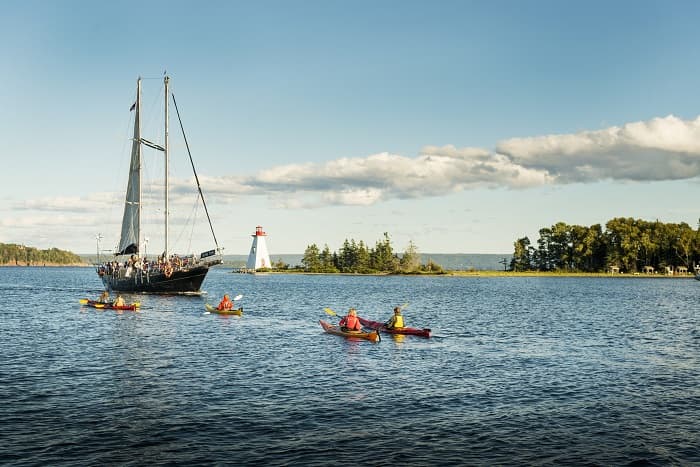
The history of human settlement in the four provinces dates back around 6,000 years to the First Nations people.
The area was later colonised by the French. With British settlements to the south in the United States, colonial wars soon followed. Visit Fortress Louisbourg in Nova Scotia to see the site of one of the original French settlements.
By the mid 1700s the Maritimes were under the control of the British. The location of the provinces made this a great place for shipbuilding, trading and fishing, especially in the 1800s.
Atlantic Canada also has its place in the story of the Titanic's tragic sinking. After hitting an iceberg, it was hoped the ship would make it to Halifax, but sadly it took just a few hours before becoming fully submerged. Ships were sent from Halifax to help the passengers, saving as many people as possible in their search and rescue efforts.
To find out more, Halifax's Maritime Museum of the Atlantic showcases the history of Nova Scotia, from the Mi’kmaw’s past and present history, to the history of the Titanic rescue by the RMS Carpathia and the golden age of shipbuilding.
4. The National Parks of Atlantic Canada
There's an array of incredible National Parks to visit in Atlantic Canada- so, where do you start when planning your holiday?
We’ve picked one for each of the provinces to give you an idea. If you like to walk and visit the untouched natural beauty of eastern Canada then check out our tour of seven national parks in the Maritimes.
Cape Breton Highlands National Park Highlights in Nova Scotia
When to visit Cape Breton National Park: September and October for the vibrant leaves, fewer crowds and fairly gentle weather.
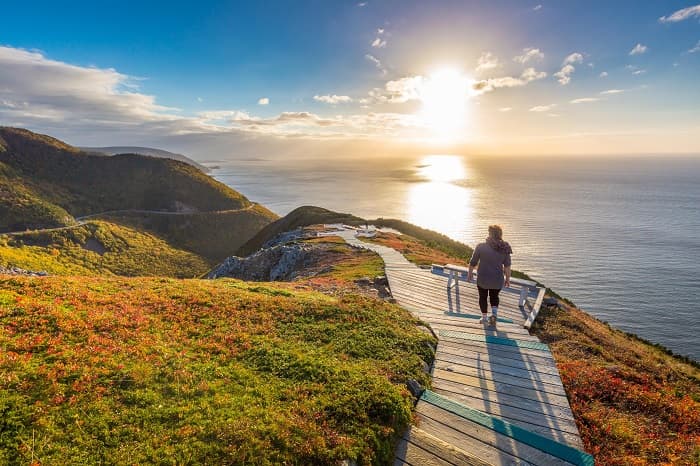
Hiking
There are 26 beautiful hikes within Cape Breton Island. One of these is the Skyline Trail that allows you to loop around and takes you through an easy to moderate 7km walk. This has some beautiful viewpoints along the way, such as the bluff that looms over the crashing Atlantic Ocean below. Traversing the park, you might also come across some local inhabitants, such as moose, bears and coyotes, so keep your eyes and ears open!
Cabot Trail
One of the most incredible drives in Canada, the Cabot Trail winds right along the coast with about five hours of non-stop beauty. Stop off to taste the catch of the day at the restaurants along your way.
Gros Morne National Park in Newfoundland and Labrador
When to visit Gros Morne National Park UNESCO World Heritage Site: June and July if you're looking to climb and hike in the best weather conditions, and for spotting the whales in the water.
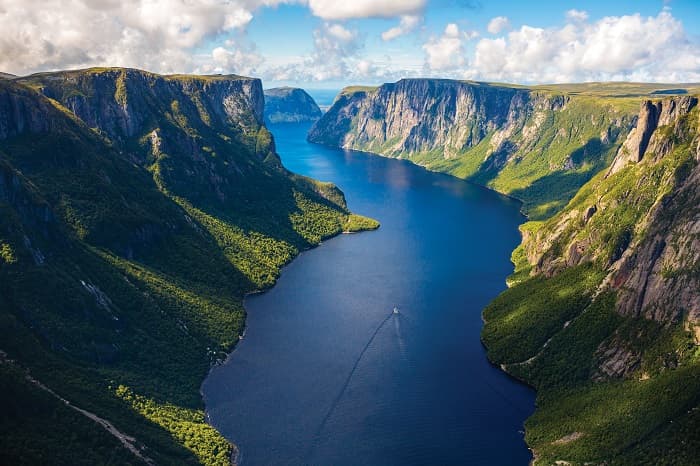
Hiking and Climbing the mountains
An absolute hiker's paradise, here you'll find everything from easy walks to more difficult climbing adventures. Easier walks include a jaunt down to the water and impressive fjords where you can pick up a boat to take you through the water. More difficult trails take you up past Baker’s Brook Falls or even an eight-hour hike up Gros Morne for the real hiking enthusiast.
The Tablelands
The park is one of the few places on earth that you can walk on the earth's mantle as it pushes through the crust. This is a brilliant example of plate tectonics and the geological history of this area of the world. Take a guided tour through the UNESCO World Heritage Site or simply just soak in the natural beauty of your surroundings.
Western Brook Pond
Another of the locations in the park that deserves special mention. This is a freshwater lake that has been carved out of the land by the glaciers and is surrounded on all sides by the steep walls of the fjords. You can take a boat tour out onto the water in the summer months.
Fundy National Park in New Brunswick
When to visit Fundy National Park: The best time to visit is during the summer, from mid June to mid September.
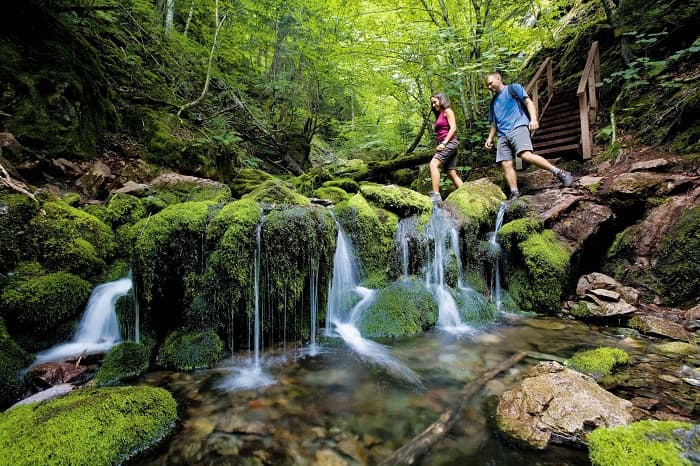
The Bay of Fundy
This is New Brunswick nature in its grandest setting. Home to the world’s highest tides, spectacular coastline, and notoriously charming communities – the Fundy Coast is a road tripper’s dream. Connect with the land, the ocean and the wide-open sky at Fundy National Park, New Brunswick's first national park created in 1948 and open year-round.
Experience the World’s Highest Tides
High and low tide is incredible in the Bay, with the water drawing out and filling back in every six hours or so (the highest tides on the planet can be found here). When the tide is out, you can wander out onto the Jurassic basin that’s left behind and when it's filled in, take the sea view route by kayak to spot seals sunbathing on the rocks.
Trail System
Fundy National Park has a large trail system creating a particularly unique and memorable experience. Come and marvel at the waterfalls, descend into moss-covered river valleys and swim in backcountry pools. If you're lucky, you may even see some of New Brunswick's wildlife!
Prince Edward Island National Park
When to visit Prince Edward Island National Park: The park is best for visiting in the summer months. It closes during the winter due to adverse weather conditions.
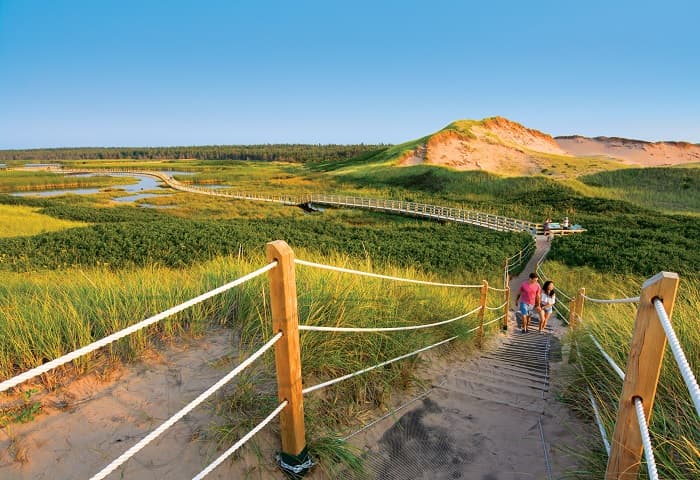
Sandstone Cliffs and Beaches
This area is coastal trail bliss. From golden sandy beaches to orange sandstone cliffs, it’s a wonderful place to spend some time in peace and quiet with nothing but the sun and waves. You can also head into the water and spot the marine life in the surf, including colourful jellyfish, crabs and lobsters.
Bird Watching
The island is absolutely bursting with flora and fauna which attract some spectacular birds, such as the rare and extremely endangered piping plover, bobolinks and the Canada warbler. The popularity of the island has led to the birds losing habitat, so there are lots of conservation efforts in the area.
From Beach to Acadian Forests
The park isn’t just beaches; you’ll also find sand dunes, salt marshes and the Acadian forest land. Visit the landscapes that inspired the writing of Lucy Maud Montgomery who wrote Anne of Green Gables.

Food and Drink to try in Atlantic Canada
If Atlantic Canada didn't already have enough on offer, it's also a fabulous destination for food lovers.
As you'd hope from its location along the icy Atlantic Ocean, seafood is a staple here.
Lobster is a favourite here. You can get a taste for them any time of year, whether you want to try them packed into a fresh lobster roll or taco, or a classically Canadian lobster poutine! Nova Scotia even has its own lobster trail, including an array of restaurants offering plenty of takes on the ingredient. You won’t want to miss snapping a photo with the iconic Giant Lobster in Shediac, the lobster capital of the world situated in New Brunswick.

Another east coast staple is clam chowder, the perfect dish for warming up with after a day searching for icebergs. For more shellfish, you'll be delighted to hear that Malpeque Bay on Prince Edward Island is known for its top quality oysters, so you won't want to miss out on tasting them.
With plenty of food to choose from, you're bounded to find a waterfront restaurant to soak in all the flavours of Atlantic Canada. You could also stop by one of the many farmers' markets throughout the region, where you can sample the freshest blueberries, or buy a jar of sweet pickle or maple syrup to take home with you.
Want to know more about visiting Atlantic Canada on your luxury holiday to Canada?
Simply contact us to speak to our Travel Specialists for some advice on tailor-making your own bespoke trip.
